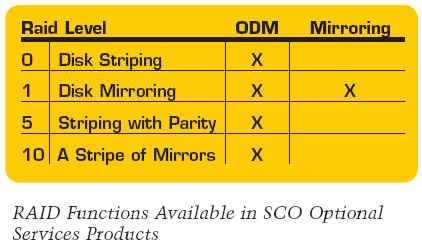|
SCO Online Data Manager (ODM) and Mirroring on SCO OpenServer™ 6 and UnixWare 7
The new, low cost SCO Online Data Manager (ODM) and Mirroring add-ons for OpenServer 6 provide customers with the tools to easily manage and protect their business-critical data.
Two new, low cost add-on management tools for OpenServer 6 provide customers with the tools to easily manage and protect their business-critical data.
With SCO Online Data Manager (ODM) and Mirroring SCO customers are able to:
- Build low cost systems using off the shelf, inexpensive disk drives and reap the benefits of improved data management and integrity with OpenServer 6.
- Provide customers with the ability to create new and enhanced applications for SCO’s new high performance application platform.
Both Online Data Manager (ODM) and Mirroring can be coupled with any standard disk system, including the new low cost Serial ATA (SATA) drives. Using these new tools with low cost disk systems will significantly lower the cost of installations that demand eas-to-use data management features and highly reliable data security.
SCO UNIX Disk Mirroring
Customers who just need a software RAID 1 (i.e. disk mirroring) solution to enhance the availability of disk storage systems without any other RAID features, have the option of purchasing a Disk Mirroring license. Disk Mirroring provides increased data availability by providing fault tolerance against disk failures and faster access via simple disk mirroring. By adding a second disk to the system and enabling Disk Mirroring, administrators will automatically have access to their business-critical data should one disk fail.
Both ODM and Mirroring are designed to work with off-the-shelf disk storage subsystems, thus supporting these advanced data management features for very cost-effective, high-availability data storage solutions.
RAID Levels Explained
 Redundant Array of Independent (or Inexpensive) Disks, RAID solutions employ two or more drives in combination for fault tolerance and performance. RAID disk drives are used frequently on servers but aren't generally necessary for personal computers. Redundant Array of Independent (or Inexpensive) Disks, RAID solutions employ two or more drives in combination for fault tolerance and performance. RAID disk drives are used frequently on servers but aren't generally necessary for personal computers.
There are number of different RAID levels:
- Level 0 – Striped Disk Array without Fault Tolerance: Provides data striping (spreading out blocks of each file across multiple disk drives) but no redundancy. This improves performance but does not deliver fault tolerance. If one drive fails then all data in the array is lost.
- Level 1 – Mirroring and Duplexing: Provides disk mirroring. Level 1 provides twice the read transaction rate of single disks and the same write transaction rate as single disks.
- Level 5 – Block Interleaved Distributed Parity: Provides data striping at the byte level and also stripe error correction information. This results in excellent performance and good fault tolerance. Level 5 is one of the most popular implementations of RAID.
- Level 10 – A Stripe of Mirrors: Not one of the original RAID levels, multiple RAID 1 mirrors are created, and a RAID 0 stripe is created over these.
SCO ODM and Mirroring requires Maintenance Pack 2 for SCO OpenServer 6.
|
